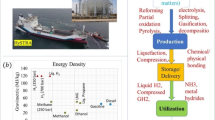Abstract
Purpose
To determine liquid nitrogen evaporation rates of intact liquid nitrogen storage tanks and tanks with their vacuum removed.
Methods
Donated storage tank performance (LN2 evaporation) was evaluated before and after induced vacuum failure. Vacuum of each tank was removed by drilling through the vacuum port. Temperature probes were placed 2 in. below the bottom of the styrofoam cap/plug, and tanks were weighed every 3 h. Evaporation rate and time from failure to the critical temperature was determined.
Result
Storage tanks with failed vacuum have a much higher evaporation rate than those with intact vacuum; evaporation rates increased dramatically within 3 to 6 h in the smaller tanks, and time to complete depletion varied according to starting LN2 volume. Tanks with storage racks/specimens may have altered evaporation profiles compared to tanks without. Locating temperature probes 2 in. below the styrofoam cap/plug suggests that for most applications, alarms would sound approximately 1 h prior to reaching the critical warming temperature, approximately − 130 °C. External signs of vacuum loss were dramatic: vapor, frost, and audible movement of air.
Conclusion
For the first time, we have data on how liquid nitrogen storage tanks behave when their vacuum is removed. These findings are conservative; each lab must consider starting volume, tank size/capacity, function (storage or shipping), age, and pre-existing evaporation behavior in order to develop an emergency response to critical tank failure. Times to complete failure/evaporation and critical warming temperature after vacuum loss are different; these data should be considered when evaluating tank alarm systems.






Similar content being viewed by others
References
Foote RH. The history of artificial insemination: selected notes and notables. J Anim Sci. 2002;80:1–10.
Polge C, Smith AU, Parkes AS. Revival of spermatozoa after vitrification and dehydration at low temperatures. Nature. 1949;164(666):70.
Pomeroy KO, Marcon M. Reproductive tissue storage: Quality control and management/inventory software. Semin Reprod Med. 2018;36:280–8.
Schiewe MC, Freeman M, Whitney JB, VerMilyea MD, Jones A, Aguirre M, et al. Comprehensive assessment of cryogenic storage risk and quality management concerns: best practice guidelines for ART labs. J Assist Reprod Genet. 2019;36:5–14.
Kelk DA, Liu Y, Nichols-Burns S, Lo J, Reed M, Pomeroy K. Analysis of a simulated liquid nitrogen storage tank failure. Fertil Steril. 2018;110(Suppl):e18–9.
Pomeroy KO. Liquid nitrogen storage tank failure: can we improve the current system? Fert Steril Dialog. 2018; https://www.fertstertdialog.com/users/16110-fertility-and-sterility/posts/33372-pomeroy-consider-this. Accessed 21 Oct 2019.
Moutos CP, Lahham R, Phelps JY. Cryostorage failures: a medicolegal review. J Assist Reprod Genet. 2019;36:1041–8.
Schiewe MC, Ochoa T, Whitney JB, Zozula S. Operational and performance qualification of 35 liter cryostorage Dewar tanks by weight measurement-fluid level correlations. Fertil Steril. 2019;111(Suppl):e29.
Alikani M. Cryostorage of human gametes and embryos: a reckoning. Reprod BioMed Online. 2018;37:1–3.
Acknowledgements
A special thanks to those that donated tanks to this study: The World Egg Bank, Colorado State University’s Animal Reproduction Laboratory, ReproTech, Ltd, Yale Fertility Center, and Kaiser Permanente Center for Reproductive Health.
Author information
Authors and Affiliations
Contributions
All authors contributed to the study conception and design and contributed to material preparation and data collection. All authors contributed to data analysis, with final review by KOP. All authors contributed to and had opportunity to comment on the original version of the manuscript.
Corresponding author
Ethics declarations
Conflict of interest
There were no conflicts of interest reported by the authors, and no compensation was received by the authors for participation in this project. No commercial, State or Federal funding was utilized in this study; materials, monitoring devices, and tanks were available in-house or were donated for the purposes described in this manuscript.
Additional information
Publisher’s note
Springer Nature remains neutral with regard to jurisdictional claims in published maps and institutional affiliations.
Rights and permissions
About this article
Cite this article
Pomeroy, K.O., Reed, M.L., LoManto, B. et al. Cryostorage tank failures: temperature and volume loss over time after induced failure by removal of insulative vacuum. J Assist Reprod Genet 36, 2271–2278 (2019). https://doi.org/10.1007/s10815-019-01597-5
Received:
Accepted:
Published:
Issue Date:
DOI: https://doi.org/10.1007/s10815-019-01597-5




